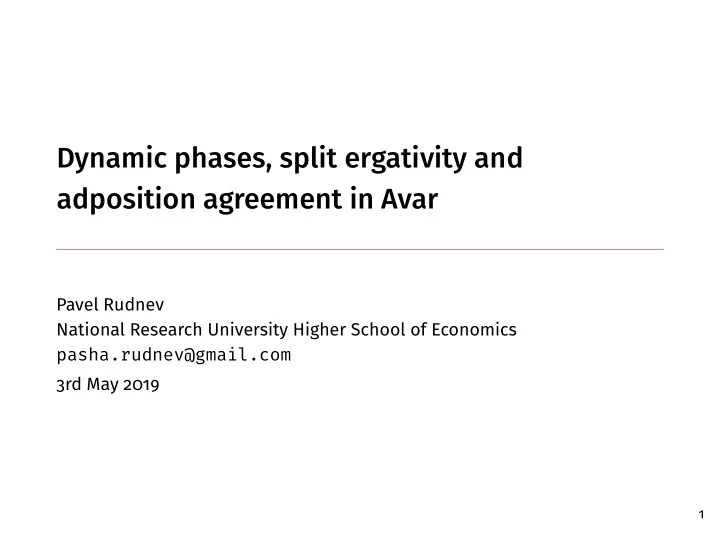

Dynamic phases, split ergativity and adposition agreement in Avar Pavel Rudnev National Research University Higher School of Economics pasha.rudnev@gmail.com 3rd May 2019 1
Introduction prog bread.abs ja- eat- te- nmlz- n loc ari d- woman.abs 3abs- a aux ‘The woman is eating the bread.’ [Basque; Laka (1996)] The additional locative structure “hides” the internal argument from the configurational procedure of case assignment. What do we do with languages where alignment splits are optional? ogia Emakumea Alignment splits, both TAM- and argument-marking based, often caught postulate added structure (e.g. Coon & Preminger 2017): (1) a. Ehiztariak hunter.erg otsoa wolf.abs harrapatu d- b. 3abs- ∅ - sg.abs- u- aux- ∅ 3sg.erg ‘The hunter has caught the wolf.’ 2
Aims and claims Aims: • examine the properties of an optional-split system in Avar • focus on two patterns involving adposition agreement Claims: • an additional source for alignment splits: spellout 3
Avar: Background • East Caucasian (Republic of Daghestan) • ca. 700K speakers • morphologically ergative in both agreement and case marking • head-final • free word order • some vP-level adpositions and oblique objects agree with abs-argument 4
Case and agreement in Avar kids.abs be- ana pst ‘Father was mowing (the) hay.’ b. łimal r- n- pl- ač’- come- ana pst ‘The kids have come.’ No intransitive verbs with erg-subjects are attested. uk’- b- Avar agreement tracks unmarked case on S- and O-arguments: b- (2) a. insuca father.erg xer hay.abs n- n ec- mow- ul- prs- e- ptcp- b 5
The Avar biabsolutive construction ptcp- • agreement with both subject and object • object cannot precede subject Key properties: ‘Father was mowing hay.’ pst ana be- uk’- m- w- m w e- In periphrastic tenses, the A-argument can appear in unmarked prs- ul- mow- ec- n- b- hay.abs xer father.abs emen (3) case: 6
Puzzle I: Oblique argument extraction restriction l- ) łimal kids.abs ʕert’ini ‹b› e ‹n›jug.ill łim water.abs t’o- pour- prs- ( *ʕert’ini ‹b› e e– ptcp– l pl r– pl– ugo aux.prs ‘The kids are pouring (the) water into a/the jug.’ [derived position] ‹n›jug.ill b. Agreeing oblique arguments may not be extracted to vP-peripheral pour- position: (4) a. łimal kids.abs łim water.abs ʕert’ini ‹b› e ‹n› jug.ill t’o- l- [neutral order] prs- e– ptcp– l pl r– pl– ugo aux.prs ‘The kids are pouring (the) water into a/the jug.’ 7
Puzzle II: mow- b. emen father.abs hani– here– b n xer hay.abs b– n– ec- ul- ana prs- e– ptcp– w m w– m– uk’- be- ana pst ‘Father was mowing (the) hay here.’ pst be- Variable agreement on agreeing vP-level adpositions: ) xer (5) a. hani– here– w m emen father.abs (*hani– here– w m hay.abs uk’- b– n– ec- mow- ul- prs- e– ptcp– w m w– m– 8
Towards an analysis: Background assumptions In Avar, vP is the locus of both case assignment and agreement licensing (Rudnev 2015): • all cases are preserved in non-finite clauses • unexpected if a high head is responsible for assigning abs case • event nominalisations and infinitival clauses are incompatible with clausal negation • morphological containment of infinitives within causatives and of event nominalisations within infinitivals • Caus° is a low head inside the event zone 9
Towards an analysis: Case erg is a dependent case assigned within a spellout domain: (6) spellout: (7) (similar in spirit to Coon & Preminger 2017) 10 obj PP ϕ V ] v ] [ Phase 1 DP erg subj [ DP abs The biabsolutive construction arises due to opportunistic early obj PP ϕ V ] v ] [ Phase 2 DP abs subj [ Phase 1 … DP abs
Towards an analysis: Puzzle I Puzzle I: rigidity of constituent order in biabsolutive construction There can therefore be no extraction of either DP abs (10) necessarily be spelled out: The structure containing the direct and oblique argument must 11 (9) *DP abs (8) *PP ϕ DP abs obj DP abs subj … subj DP abs obj … obj PP ϕ V ] v ] [ Phase 2 DP abs subj [ Phase 1 … DP abs obj or PP ϕ .
Towards an analysis: Puzzle II Solution: downwards phrasal probing (Carstens 2015) Object agreement obtains in Phase 1 [subject agreement] b. [object agreement] Puzzle II: Agreement variability (13) a. DP abs (12) (11) 12 PP ϕ DP abs subj PP ϕ DP abs subj DP abs obj … obj … subj [ Phase 1 PP ϕ [ Phase 1 … DP abs [ Phase 2 DP abs obj V ] v ] ] [ Phase 2 PP ϕ [ Phase 2 DP abs subj [ Phase 1 … DP abs obj V ] v ]] • PP ϕ cannot move to vP-peripheral position
Conclusions • spellout domains play a crucial role in determining alignment in Avar • this is an additional source of alignment splits, complementary to added structure (Coon & Preminger 2017) 13
Recommend
More recommend